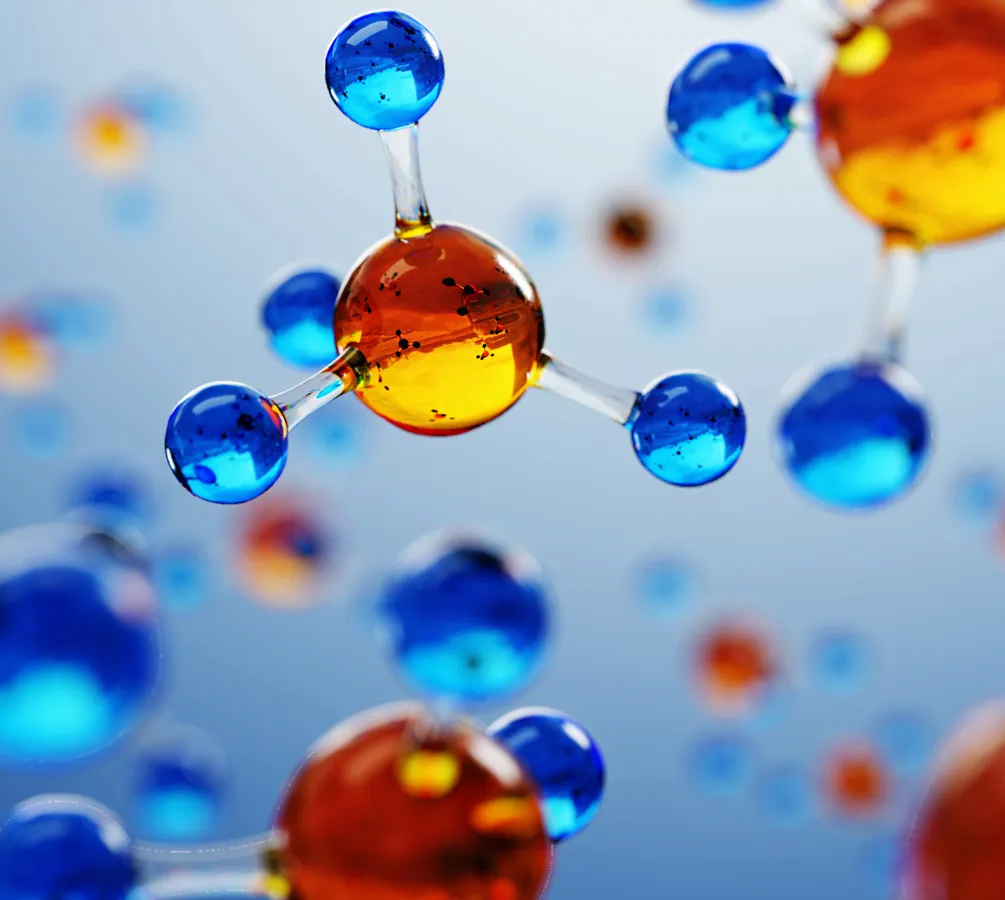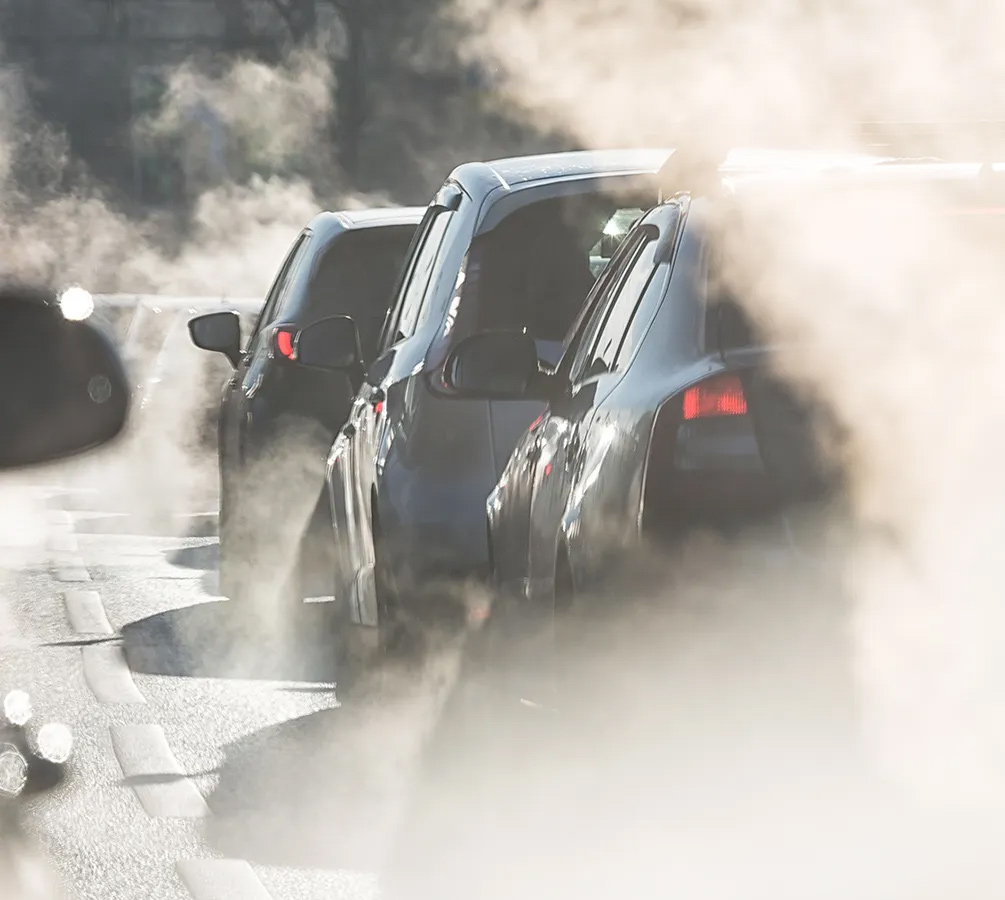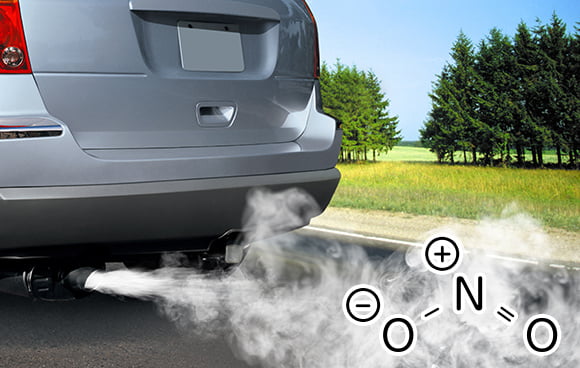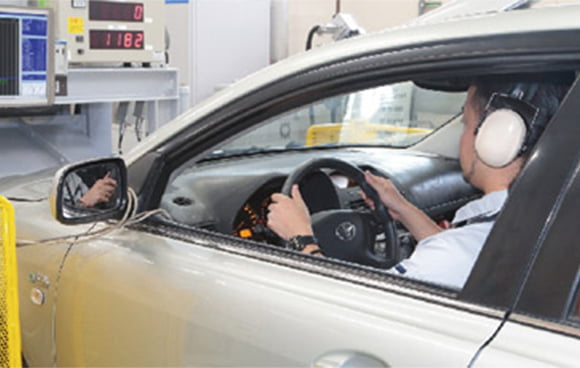- Home
- Products
- Gasoline engine catalysts
- Restart NOx emission suppression material (SRR-MIX)
Restart NOx emission suppression material (SRR-MIX*)
To suppress nitrogen oxide (NOx) at engine restart after idling stop, aim at enhance NOx purification reactions, we investigate the composite zirconium (Zr) oxide which is a carrier for rhodium (Rh) has been carried out. Based on the results, we have been developing the washcoat material (SRR-MIX) which enhances a steam reforming reactions and works specially for Nox under engine stop/go conditions. * SRR-MIX: Abbreviation for Steam Reforming Reaction-Mix-Material

Reduction of exhaust gas in real driving emission (RDE*)
The next round of European regulations, Post Euro 6 and Euro 7, will strengthen fuel consumption regulations to reduce carbon dioxide (CO2) emissions as a response to the problem of global warming, while at the same time, nitrogen oxides (NOx) and PM (micron-sized solids such as soot, and liquid microparticulate matter), which are causes of air pollution, are also said to be regulated more strictly than ever before.
RDE (Real Driving Emission)
In September 2017, Europe introduced RDE regulations aimed at reducing harmful gases emitted when driving on the road.



- Source: Worldwide Emission Standards @DELPHI
European Commission materials
PN (Particulate Number) regulation
The number of very fine PM is counted, and kept within a standard value. Until now, it was required that the weight of PM adhering to the filter be within the standard value. The PN regulation, on the other hand, measures the amount of particles emitted not by weight, but by the number of particles.
CF: Conformity Factor
Upper limit value by RDE = regulation value @ bench test x CF
In other words, the smaller the CF, the stricter the requirements for reducing exhaust emissions.
The atmosphere of exhaust gas from the engine (*) changes depending on how the car is used in each region. For example, the atmosphere, temperature, and flow velocity of exhaust gas are different on roads with frequent acceleration and deceleration due to traffic jams and on highways such as autobahns. The next regulation will strongly require the reduction of exhaust emissions in such a real driving environment (RDE).
*What is the atmosphere of the gas emitted from the engine?
This refers to the ratio of fuel and air (air-fuel ratio).
When looking at the air-fuel ratio, a lean fuel state is called an oxidizing atmosphere [lean], and a rich fuel state is called a reducing atmosphere [rich]. This Rich/Lean atmosphere of an exhaust gas oscillates rapidly depending on vehicle driving conditions.
What is required for exhaust gas purification catalysts for automobiles


A stable purification reaction even in a high-temperature environment.
To put it simply, exhaust gas purifying catalysts for automobiles are made by attaching precious metals to highly heat-resistant materials.
In the catalyst, precious metals oxidize or reduce harmful gases (carbon monoxide/CO, hydrocarbons/HC, nitrogen oxides/NOx) contained in exhaust gas from automobile engines. CO and HC are purified by oxidation reactions, while NOx is purified by reduction reactions, and the system must be designed so that the purification reactions are stable even in high-temperature environments exceeding 1,000℃.


Development of catalysts suitable for idling stop
The development of exhaust gas purification catalysts for automobiles takes a different direction based on the exhaust gas atmosphere. The emissions atmosphere depends on the engine control, so if the engine changes, the optimum catalyst will also change. In particular, idling stop vehicles, which have become popular in recent years, require the development of a catalyst suitable for idling stop because the engine control is significantly different from that of conventional vehicles. Further, in the context of protecting the environment and reducing the use of exhaustible resources, emissions regulations are becoming stricter year by year, and there is also a need to reduce the use of precious metals.
What's inside an automotive catalyst?
The components of automotive exhaust gas purification catalysts can be roughly divided into two parts: precious metals (platinum/Pt, palladium/Pd, rhodium/Rh) that are key to purifying toxic gases, and materials (carriers) that serve as scaffolding for the precious metals. The carrier consists of composite oxides such as zirconium (Zr) and cerium (Ce), with secondary components added to enhance heat resistance and/or inhibit aggregation of precious metals.
Differences in emissions between conventional vehicles and idling stop vehicles
- In a conventional vehicle, once the engine is started, the engine will continue to run even if the accelerator pedal is not depressed. This state is called idling, and gasoline is consumed little by little. On the other hand, idling stop vehicles, which have become popular in recent years, stop the engine for a certain period of time, such as at a red light, and restart the engine when the accelerator is depressed to resume driving. Idling stop vehicles may emit nitrogen oxides (NOx) when restarting.
-

Engine control and NOx emission behavior of conventional and fuel-efficient vehicles

Why is NOx emitted when restarting an idling stop vehicle?
Nitrogen oxides (NOx) are emitted when restarting an idling stop vehicle because the atmosphere of the exhaust gas flowing into the catalyst changes due to differences in engine control. In the case of a conventional vehicle, the engine is kept running in an idling state (ready to start at any time) while waiting for a signal, so the gas atmosphere in the exhaust system is maintained, and the precious metal in the catalyst can be kept active. However, the idling stop vehicle has its engine stopped while waiting for a traffic light, so that excess oxygen in air flows into the catalyst, which makes the precious metals an inactive oxidized state. If the engine is restarted in this state, the exhaust gas from the engine cannot be purified and NOx emissions will occur.
Principle of restart NOx emission


Development that changes the properties of the carrier rather than suppressing deterioration of the precious metal it supports
The material (carrier) used in automotive catalysts consists of zirconium (Zr) oxides to which elements such as cerium oxide (CeO2) and lanthanum oxide (La2O3) are added. Toxic gases are purified by supporting (adhering) precious metals to the carrier, but the properties of precious metals change depending on the composition of the carrier. Conventional catalyst development has focused on the concept of suppressing the deterioration of precious metals. For example, the purpose is to prevent the deterioration of precious metals by adding elements that improve heat resistance to Zr oxide, and stabilize the scaffold. At Cataler, instead of suppressing the deterioration of precious metals, we wondered whether it would be possible to improve the purification performance of the catalyst by changing the properties of the carrier that is the scaffold. We are now developing catalysts from this viewpoint.
Conventional catalyst development has focused on the concept of suppressing the deterioration of precious metals. For example, the purpose is to prevent the deterioration of precious metals by adding elements that improve heat resistance to Zr oxide, and stabilize the scaffold.
At Cataler, instead of suppressing the deterioration of precious metals, we wondered whether it would be possible to improve the purification performance of the catalyst by changing the properties of the carrier that is the scaffold. We are now developing catalysts from this viewpoint.
Development history of restart NOx emission suppression material (SRR-MIX)
-Chemical reactions other than toxic gas purification also occur in the catalyst-
Is it possible to make a NOx reducing agent?
Purifying nitrogen oxides (NOx) requires a reducing agent to reduce NOx.
However, since the catalyst is oxided to inactive state during an idling-stop, it can not purify an exhaust gas immediately after an engine-restart. Therefore, we wondered if it would be possible to create a reducing agent that reduces NOx at the same time as purifying NOx, and started to develop it.
Steam reforming as an additive!
NOx coming from ICE (internal combustion engine) is converted by either a reduction reaction with hydrocarbons (HC) and carbon monoxide (CO) or a reduction reaction with hydrogen (H2). We have focused on H2, which is the strongest reducing agent in exhaust gas, and investigated additive elements that promote H2 generation.
Comparison of elementary reactions (*)
By comparing the elementary reactions with different additives, we found the effective element for the desired functions and successfully added the precious metal carrier material. A vehicle evaluation was performed with a catalyst using that material.
*Elementary reactions are the individual basic reactions that make up a chemical reaction.

Characteristics of restart NOx emission control material (SRR-MIX)
As a result of comparing a conventional catalyst and a catalyst using the restart NOx emission control material (SRR-MIX) in a vehicle evaluation, the catalyst using SRR-MIX is confirmed to suppress Nox emission at an engine-restart after an idling-stop. (Left graph). In addition, we were able to reduce total NOx emissions by 35% (Right graph). Emissions regulations are expected to become stricter than ever in countries around the world. In addition, hybrid Electric vehicles (HEV) and plug-in hybrid Electric vehicles (PHEV) that combine gasoline and electricity are expected to become widespread.
As the environment of automotive emission catalysts is expected to change significantly in future, we need to continue to develop new materials based on the technology developed to date. In the future, we will analyze SRR-MIX in more detail, and apply the analysis results to new material development.
-
Restart NOx emission behavior during vehicle evaluation
-
Comparison of total NOx emissions
As a result of comparing a conventional catalyst and a catalyst using the restart NOx emission control material (SRR-MIX) in a vehicle evaluation, the catalyst using SRR-MIX is confirmed to suppress Nox emission at an engine-restart after an idling-stop.
-
Restart NOx emission behavior during vehicle evaluation
In addition, we were able to reduce total NOx emissions by 35%.
-
Comparison of total NOx emissions
Emissions regulations are expected to become stricter than ever in countries around the world. In addition, hybrid Electric vehicles (HEV) and plug-in hybrid Electric vehicles (PHEV) that combine gasoline and electricity are expected to become widespread.
As the environment of automotive emission catalysts is expected to change significantly in future, we need to continue to develop new materials based on the technology developed to date. In the future, we will analyze SRR-MIX in more detail, and apply the analysis results to new material development.


 JAPANESE
JAPANESE

 Select Language
Select Language English
English








